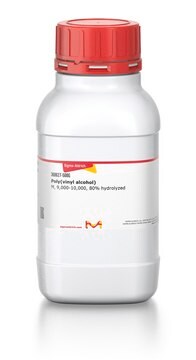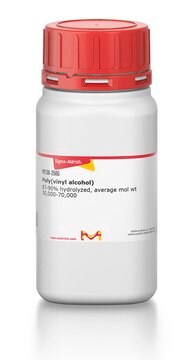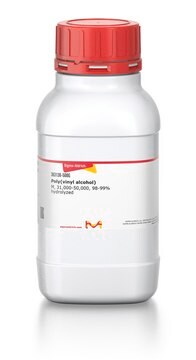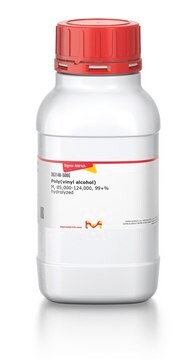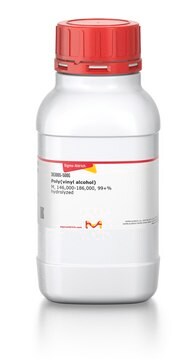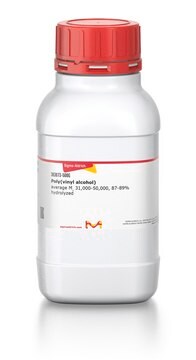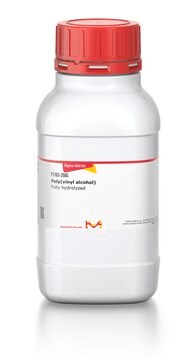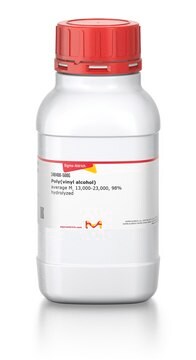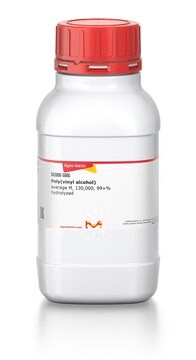363170
Poly(vinyl alcohol)
Mw 13,000-23,000, 87-89% hydrolyzed
Synonym(s):
PVA
Sign Into View Organizational & Contract Pricing
All Photos(2)
About This Item
Linear Formula:
[-CH2CHOH-]n
CAS Number:
MDL number:
UNSPSC Code:
12352104
NACRES:
NA.23
Recommended Products
form
crystalline powder
crystals or granules
powder
mol wt
Mw 13,000-23,000
falling ball
3.5-4.5 cP, 4 % in H2O(20 °C)(lit.)
InChI
1S/C2H4O/c1-2-3/h2-3H,1H2
InChI key
IMROMDMJAWUWLK-UHFFFAOYSA-N
Looking for similar products? Visit Product Comparison Guide
General description
Polyvinyl alcohol(PVA) is a linear hydrophilicsynthetic polymer with a monoclinic crystal structure. It can be synthesized via the polymerization of vinyl esters orethers, with subsequent saponification or transesterification. Due to itsexcellent physical and chemical properties, PVA has been widely used inadhesives, fibers, paper industry, drug delivery, and tissue engineering.
Application
PVA is used as a biological reagent to test the dispersion of zinc oxide nanoparticles. PVA has been evaluated as an effective protein resistant material.2 It may be used to stabilize gold colloids of diameter 3-8nm.
Poly(vinyl alcohol) can be used as a secondary template in the synthesis of mesoporous zeolites.
It can be used to prepare a hydrogel template to produce homogeneous microparticles for sustained drug release. PVA is used as a stabilizer in micro-particle preparation due to its high tensile strength and flexibility.
It can be used to prepare a hydrogel template to produce homogeneous microparticles for sustained drug release. PVA is used as a stabilizer in micro-particle preparation due to its high tensile strength and flexibility.
Features and Benefits
- Good mechanical and chemical stability
- Non-toxic
- Tunable hydrophilicity
- Resistance to solvents Capable of forming films
Storage Class Code
11 - Combustible Solids
WGK
WGK 1
Flash Point(F)
No data available
Flash Point(C)
No data available
Personal Protective Equipment
dust mask type N95 (US), Eyeshields, Gloves
Choose from one of the most recent versions:
Already Own This Product?
Find documentation for the products that you have recently purchased in the Document Library.
Customers Also Viewed
Gold colloidal nanoparticles sized to be suitable precursors for heterogeneous catalysts
Porta F and Prati L
Metal Nanoclusters in Catalysis and Materials Science: The Issue of Size Control, 355-355 (2008)
Zinc oxide nanoparticles as selective killers of proliferating cells.
Taccola L, et al.
International journal of nanomedicine, 6, 1129-1140 (2010)
Solmaz Hajizadeh et al.
Journal of chromatography. A, 1274, 6-12 (2013-01-08)
In this work, a new macroporous molecularly imprinted cryogel (MIP composite cryogel) was synthesized by glutaraldehyde cross-linking reaction of poly(vinyl alcohol) (PVA) particles and amino-modified molecularly imprinted core-shell nanoparticles. The MIP core-shell nanoparticles were prepared using propranolol as a template
Han Zhu et al.
Biosensors & bioelectronics, 49, 210-215 (2013-06-15)
A novel, facile and green approach for the fabrication of H2O2, glutathione (GSH) and glucose detection biosensor using water-stable PVA and PVA/PEI nanofibers decorated with AgNPs by combining an in situ reduction approach and electrospinning technique has been demonstrated. Small
Nadège Grabowski et al.
International journal of pharmaceutics, 454(2), 686-694 (2013-06-12)
In vitro cytotoxicity and inflammatory response following exposure to nanoparticles (NPs) made of poly(lactide-co-glycolide) (PLGA) have been investigated on A549 human lung epithelial cells. Three different PLGA NPs (230 nm) were obtained using different stabilizers (polyvinyl alcohol, chitosan, or Pluronic(®)
Our team of scientists has experience in all areas of research including Life Science, Material Science, Chemical Synthesis, Chromatography, Analytical and many others.
Contact Technical Service
